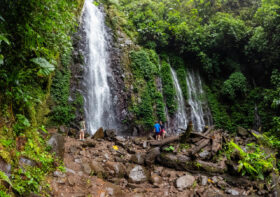Meteora, Greece, is a shock, in the best way possible
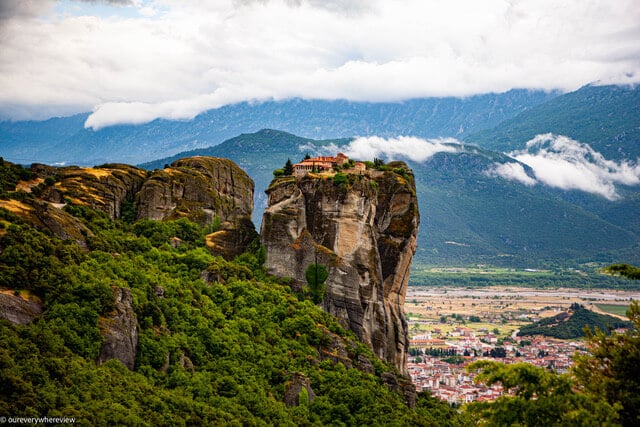
You’ll typically find us writing about sites worth seeing as “attraction spotlights”. We generally review the locale’s history and significance, followed by practicalities of visiting the site, and take you on a tour of what we did (or what in hindsight we wished we did).
I’m not sure I can do that for Meteora, Greece. I’m almost certain that even back home and thousands of miles away, I’m still so excited to talk about this incredible spot it’s all going to come spilling out as incoherent verbal diarrhea.
We were on the fence about visiting Meteora. Many travellers to Greece are. This is partly because many don’t know about it (it’s a far cry from classical Ancient Greece), but also because it. is. far. Meteora is located at the northwestern point of the plains of Thessaly in Central Greece. It is at least a 4 hour drive from Athens, and there is not a whole lot else to do in the region. But if this blog post does anything, we hope it convinces readers and travellers on the fence, as we were, that Meteora is totally worth the effort.
Meteora means “suspended in the sky”. And it is truly and out-of-this-world sight. Even though it was drizzling almost the entire time we were there. Even though the sunset tour we had booked didn’t have one ray of sunshine in sight. We were still blown away, each turn in the road an astounding, breath-taking sight. Meteora is an enduring piece of history, a solemn dose of religion, and a feast for the eyes. You will not regret making the trek out here.
Have I seen it somewhere before?
You may have! Meteora’s landscape is *very* distinct. It makes an appearance in:
–> the end bit of James Bond, 1981, For your Eyes Only.
–> inspiration for the Eyrie where Tyrion was held in Game of Thrones
The astounding geography and history of Meteora
Now that we’ve built up the suspense… what is Meteora? Meteora is a collection of Eastern Orthodox monasteries built on top of giant rock pillars.
First of all, the rock pillars, part of the Pindos mountains, are a bit of a geographical mystery. It looks like some giant was sculpting with play-doh. It’s believed that the seabed was pushed up in a series of mini earthquakes/plate movements, and fault lines created the ridges in the seabed. Over time, weather and erosion shaped the rock pillars into what we see today.
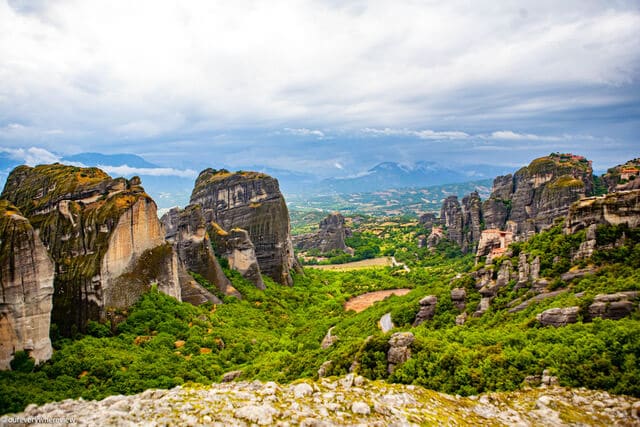
Because their nearly inaccessible location made them relatively safe, monks starting living in Meteora as early as 9th century AD. These early monks lived in caves and fissures in the rock, and were mostly solitary. The first monasteries did not appear until the 12th century AD, and most were built during the 14th century AD, as a refuge to escape Turkish invaders at the time. This was an astounding feat, as all the supplies were transported up to the top of these pillars using ladders lashed together and ropes and nets. For hundreds of years, this was the only way to reach the monasteries. In 1920, stairs were cut into the pillars, and the monasteries could be reached via bridge.
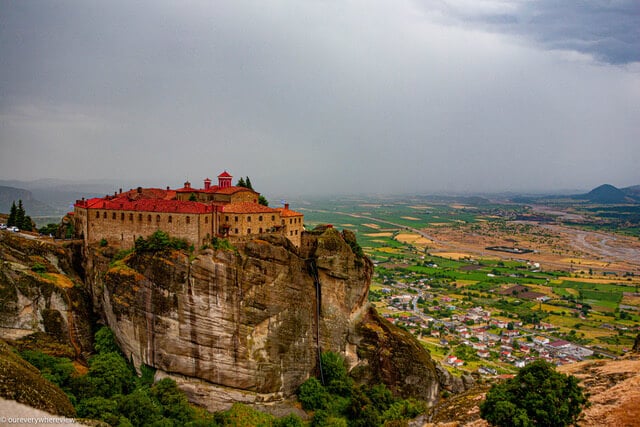
All in all, there are over 20 monasteries, housing monks and nuns serving the Eastern Orthodox Church. Right now, only six of them are active, and on average each only houses 10 monks or nuns. There are many more visitors, and Meteora has been designated a UNSECO world heritage site. Meteora is also a popular destination for rock climbers!
The monasteries
Should I see them all?
To be honest, the most mind-boggling part of Meteora is driving around every corner and seeing another monastery perched high on the rock pillars. It is really the combination of nature wonder and human tenacity that makes Meteora so unique. To that end, we didn’t tour all the monasteries. (A combination of closure, poor weather, and taking a tour that ate away a significant chunk of our time.)
We visited 3 of the 6. They are all quite different aesthetically and functionally. I think it would have been neat to see them all, but we got a pretty good sense of the workings. Each monastery has courtyard and very well-tended gardens. Inside, each has a very frescoed “katholicon” (the main church building used for worship), and relics on display. As working monasteries, all of them have sections open to the public, and sections that are closed off. (You are not allowed to take photos inside the monasteries, so all of our photos are of the outside or courtyard.)
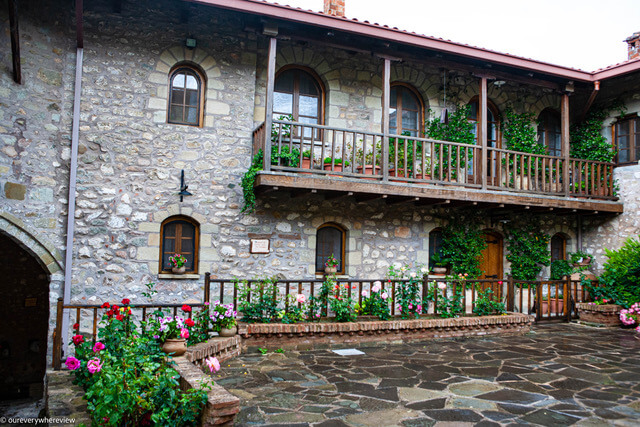
If you plan to tour all the monasteries, one or two will be closed each day of the week, so it will take minimum of two days.
The Great Meteoron
This is the largest and oldest of all the monasteries. (From the parking lot, you also get an impressive view of the Varlaam Monastery.) It has a feel of a medieval village. The main church has some beautiful frescos, and there is a kitchen complex and a museum. The museum holds a number of Meteora’s artifacts.
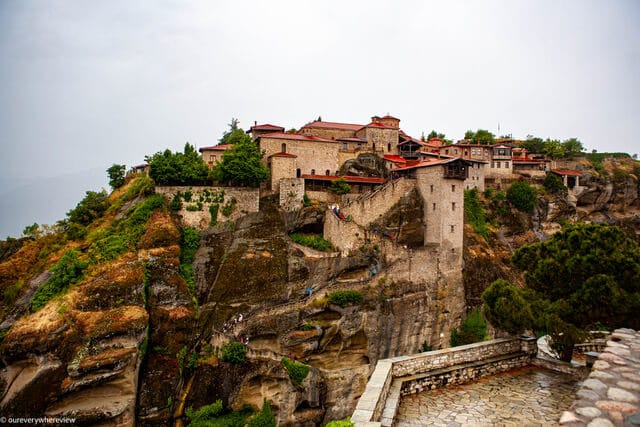
Varlaam Monastery
Varlaam is Meteora’s second largest monastery. Unfortunately, this monastery was closed the day we visited. I think this would have been the most interesting to see as it contains the history of how Meteora came to be and how the monks once lived. In the museum you can even see original nets and pulleys of how the monks hauled their supplies up the rock pillar.
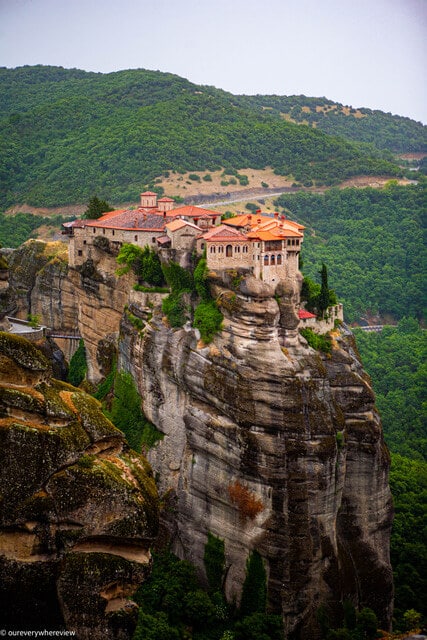
St. Stephen Monastery
This is now a nunnery, housing nearly 30 nuns. It’s also the busiest of all the monasteries we saw, probably as it is the most accessible (no stairs, just a small bridge from the parking lot).
There are two chapels here, one of which was damaged in WWII and the Greek civil war. The gardens are beautiful, and this monastery offers a spectacular view of the surrounding countryside.
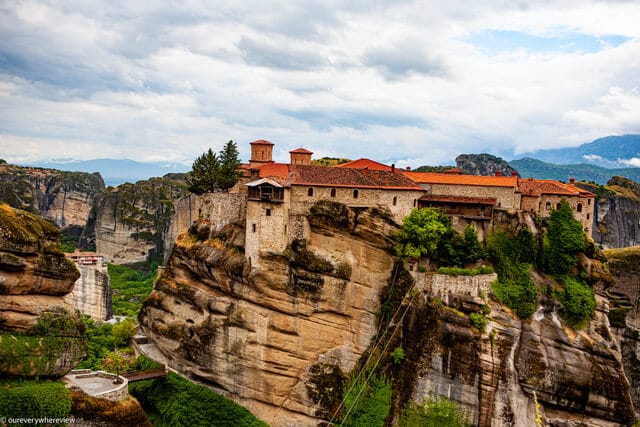
Holy Trinity Monastery
In contrast to St. Stephen’s, Holy Trinity is probably the least accessible. The only way to get here is up 140 steps. It is the most dramatic looking (see featured image at top of top), and is the monastery featured in James Bond’s “For Your Eyes Only”. The main chapel houses some beautiful fine-art paintings.
Roussanou Monastery
Rousannou Monastery is now also a nunnery. It is one of the smaller monasteries, but is easily accessible as it is set on a lower rock.
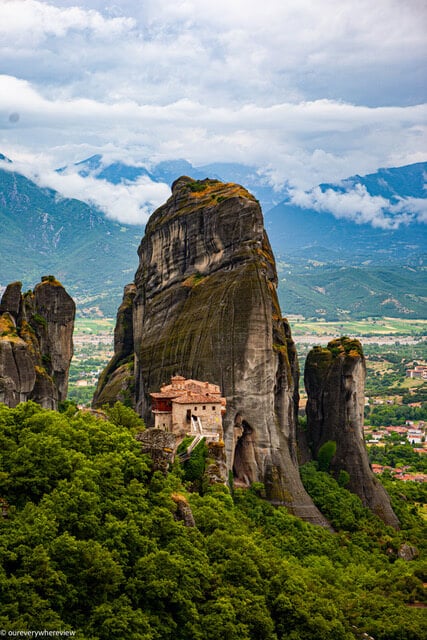
St. Nikolaos Anapafsas Monastery
This is Meteora’s smallest monastery, run by one monk. It’s the closest to the town of Kastraki, and is an easy first or last stop. (It’s also possible to walk here from Kastraki.) The monastery is built against the cliff wall, so a bit of a steep trek getting here.
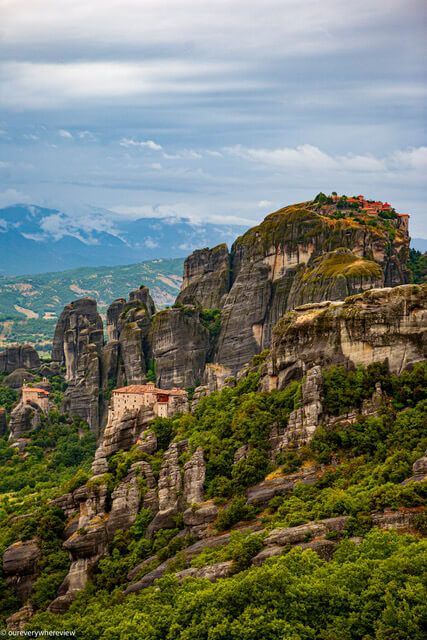
How to see Meteora
Meteora can be done as a day trip from Athens – a very long one. As we mentioned, it’s a 4 hour drive each way. It is worth staying overnight (even for the mood alone! It’s a little spooky sleeping in the shadow of giant rock pillars.) If it’s a sunny day, you can catch a spectacular sunset from Meteora.
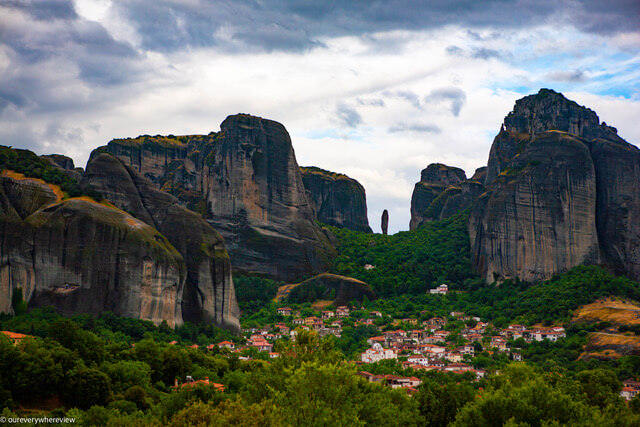
Where to stay overnight
We recommend Kastraki, a little village right at the base of the mountains. It has a distinct local flavour, although most of its population work in tourism. It has enough boutique hotels and restaurants/tavernas to be comfortable. If you’re an early riser, you also have a good chance of catching sunrise over Meteora. (I am not, which is why we chase sunsets!) Kastraki is also the closet town to Meteora. There is path you can hike to St. Nikolaos Anapafsas that is approx 1.5km.
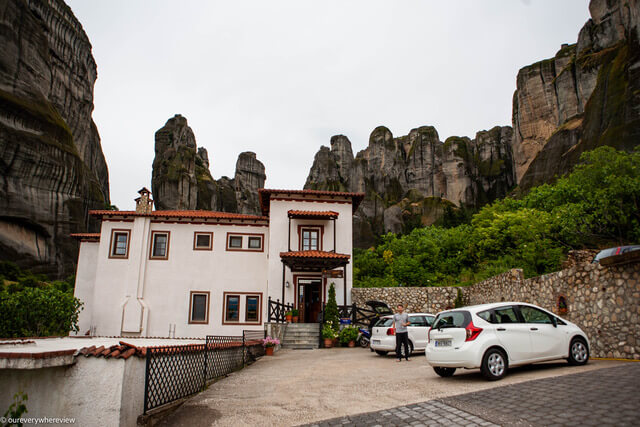
Kalambaka is the main town. It’s a little further away (3km), but has more amenities and restaurants. It’s also where the train arrives from Athens.
Drive and self-guided tour
If you are driving, the drive from Athens to Meteora is a nice, easy highway drive (unlike many other places in Greece!) We drove in from Delphi, and the first two hours of it was twisting, winding mountain roads (much more classic of Greece.)
Driving through Meteora lets you explore at your own pace. However, unlike many ancient sites in Greece, you won’t be able to avoid the crowds by visiting at “off peak” hours, due to the monasteries’ opening times.
Day Tour
If you opt for a day tour, there are many options that get you to Meteora, by either bus or train. The tour buses stop at the monastery parking lots. The train tour (highly rated, I hear) will get you into the local town, then the actual tour starts by minibus. Most tours start extra early (depart at 6:30am), in order to arrive when the monasteries open at 9am. Taking a tour here *is* helpful, (you will find I have differing opinions on group tours in Greece depending on the site in question). Especially as our Byzantine Empire knowledge is shallow, we found having a guide explain the significance and complexity of Byzantine history helpful.
Train and local tour
If you don’t do the day tour, and you don’t plan to drive, you can still take the train. Tickets cost upward of 27€, and will take you to Kalambaka. From there, you can hire a local tour. Many tours will come to the station or your hotel to pick you up. There is also a public bus, but we do not recommend this option. There is a stopover, and takes almost 6 hours.
Bike or hike!
If you are particularly adventurous, there is also the option of doing a bike tour. OR, lastly, you can hike! It’s about 16km to hike to all the monasteries.
Our local tour experience
We drove in to Meteora, but still elected to do take a local tour. We chose to do the sunset tour through Visit Meteora Travel, which was a very popular option. The tour came to pick us up from our hotel in a minibus, along with maybe 8 other guests.
Unfortunately, our “sunset” was rained out, but we still took the tour. We got a nice panorama of Meteora where the tour would have stopped for a sunset view. What I liked about the tour was the background info on Meteora and the history of the Byzantine empire. The tour also stopped at some of the earlier hermit caves, which I don’t think we would have found on our own. While in town (Kalambaka), we stopped at the Byzantine temple of Dormition of the Mother of God. This church is still in use by locals. The floors are covered in mosaics and the walls in art. Our guide explained the basics of Byzantine art, which I knew *nothing* about. In all, the tour lasted about 4 hours.
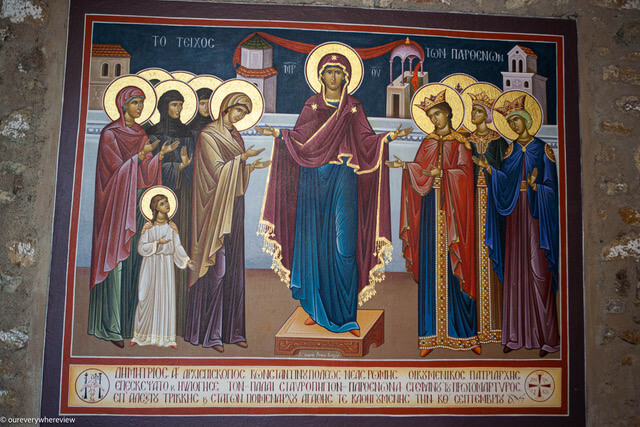
The downside of a sunset tour is it doesn’t start until late afternoon (4:30pm). Most of the monasteries close between 4:00pm and 5:30pm. With the tour, we only got to explore inside one monastery, and the rest was seeing the surroundings from the outside. I don’t think I would have been satisfied if we didn’t also have the option of seeing some of the others separately. You can also consider combining the sunset tour with one of the other daytime tours. The tour also didn’t provide a guide for when we got inside the monastery.
Ultimately, if you have the option of driving, we found it wasn’t worth taking a tour. As long as you have a good guidebook or some knowledge of the monasteries, you can easily explore Meteora on your own with more flexibility.
Points to remember before visiting
Unlike many ancient sites in Greece, Meteora is still inhabited and is a place of worship. You will not be allowed to take photos inside the monasteries, but it is also good practice not to disturb the monks or nuns going about their daily business.
When you visit, men are required to wear pants, and women long skirts. Shoulders need to be covered (scarves work well for this!) Skirts are provided at each monastery if you need one.
This region of Greece tends to be rainy, so a good idea to have a rain jacket on hand. We visited in June and it drizzled the entire time!
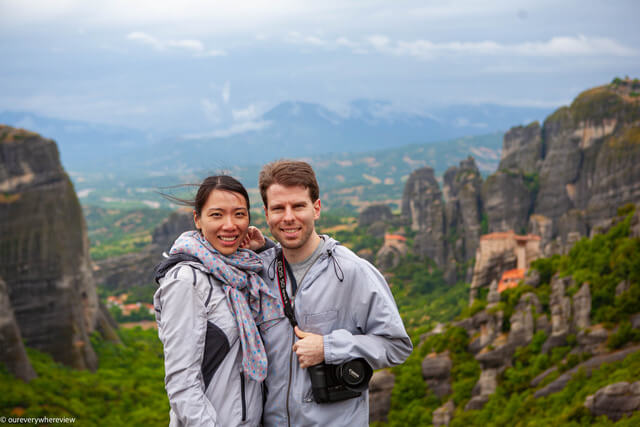
If you’re planning a trip to Greece, you won’t regret making the trip to Meteora. (And if you’re like us, you will talk about it any time someone mentions traveling to Greece for years to come.) Have questions about Meteora? Drop us a note!
Planning your trip to Greece? Start here: Two-week Greece itinerary


